Roy Lichtenstein 6 X 9 of Art 1962 the Ring Small
April 18, 2019
roy lichtenstein 1961 to 1965
Gillian Pistell examines Roy Lichtenstein's aesthetic developments in the years 1961 to 1965. This quantum catamenia in the artist's career saw his first utilization of the Benday dot technique and marked a turning indicate in his choice of subject matter.

Gillian Pistell joined Gagosian in May 2017 equally a researcher and author. She received her doctorate in art history from the Graduate Eye, CUNY, in February 2019. Prior to Gagosian, she worked as a inquiry assistant in the Modernistic and Gimmicky Art Department at the Metropolitan Museum of Art, New York, and has contributed to several scholarly publications, including Pen to Newspaper: Artists' Handwritten Letters from the Smithsonian'southwardArchives of American Fine art.
See all Articles
In the fall of 1961, functioning artist Allan Kaprow arranged a meeting betwixt Roy Lichtenstein and Ivan Karp, manager of the influential Leo Castelli Gallery in New York. The purpose of the meeting was to show Karp four of the new "comic volume paintings" that Lichtenstein had recently fabricated. The paintings, The Engagement Ring (1961), Girl with Ball(1961), Expect Mickey (1961), and Footstep-on Tin with Leg (1961), featured cartoon-like depictions of mass media imagery, some taken from comic books while others from advertisements, and combined elements painted by hand with concepts borrowed from mechanical reproduction.1 Namely, Lichtenstein utilized the Benday dot method, or dots of color from the four-color process printing arrangement (cyan, magenta, yellowish, and black) to create secondary colors and shading. Kaprow recognized the radical nature of these canvases, particularly in the continuing wake of Abstract Expressionism. Lichtenstein had developed an entirely new artful language that transformed the visual culture of everyday life into a discipline matter for high art—the beginnings of what would become known as Pop art.
Kaprow and Lichtenstein met while instruction at Douglass Higher, part of Rutgers University in New Brunswick, New Bailiwick of jersey. Kaprow had been teaching at Rutgers since the early 1950s, and had spearheaded what would become a thriving avant-garde art scene, largely motivated by the ideas he learned from musician John Cage, whose classes he attended at the New School in nearby New York. Muzzle inspired Kaprow—along with numerous other artists of the time—to embrace aspects of everyday life in fine art, rather than use fine art equally a ways to escape life.two Subsequently, Kaprow penned the essay "The Legacy of Jackson Pollock" two years later the venerated Abstruse Expressionist's death, in which he offered a novel perspective on Pollock's contribution to the development of advanced fine art: "Pollock, as I meet him, left usa at the bespeak where we must become preoccupied with and even dazzled past the space and objects of our everyday life, either our bodies, clothes, rooms, or, if demand be, the vastness of Forty-second Street." He went on to clarify: "Objects of every sort are materials for the new art: paint, chairs, food, electrical and neon lights, smoke, h2o, old socks, a domestic dog, movies, a thousand other things that volition be discovered past the present generation of artists."3
Kaprow's cohorts at Rutgers, including Robert Watts, George Brecht, Lucas Samaras, George Segal, Robert Whitman, and Geoffrey Hicks, likewise assumed this radical stance of embracing contemporary life in art, and it was into this temper that Lichtenstein arrived with his Abstract Expressionist and post-painterly canvases when he joined the faculty in 1960. Lichtenstein'south new colleagues encouraged him to carelessness the ascendant styles to which he had adhered for the previous several years, and to remember that "fine art doesn't have to look like art," as Kaprow often stated. This encouragement grew stronger when Lichtenstein's new colleagues discovered his painterly drawings of the iconic American cartoon characters Mickey Mouse and Donald Duck. They praised his use of conventional "low culture" for high art, and urged Lichtenstein to farther button that notion.4 Consequently, Lichtenstein created the seminal Benday dot, comic-inspired paintings for which he is most known today.
Among these early on forays into comic book imagery were numerous depictions of women. Though women would figure periodically throughout Lichtenstein's career, their appearance as focused subject area matter was notably prominent in this showtime phase, from 1961 to 1965. Many accept the form of high-drama depictions of women in the throes of emotional malaise—typically at the easily of men—from melodramatic scenes in comic books.5 Others, however, were modeled off the ever-present advertisements in magazines and other printed publications like the Yellow Book, a telephone directory that was consistently replete with small, illustrated ads for local businesses. Indeed, two of the four paintings shown to Ivan Karp in the higher up-mentioned meeting were of women: The Appointment Ring and Girl with Ball. Information technology was these paintings of women that sparked Karp's interest, specifically Girl with Ball, and prompted him to encourage Leo Castelli to represent Lichtenstein at his gallery.6
The women in Lichtenstein's 1961–65 paintings are every bit anonymous as they are cute. The predominating palette in these works, of crimson, yellowish, blue, green, and blackness, emphasizes their mass media sources, while also ensuring that the works maintain a strong compositional integrity—a quality farther ensured by Lichtenstein'south method of using a rotating easel which allowed him to rotate his canvases to confirm that their compositions worked when positioned in all possible orientations.7 Girl with Ball, painted in yellowish, blue, and red, with bold blackness lines, falls in this category of depictions of archetypal women; the figure was based on an advertisement for a resort in Pennsylvania's Poconos Mountains. In the painting, however, Lichtenstein generalized the woman's features, flattening any sex activity appeal she might have to lucifer the commercialized artful of the Benday dots in which she is represented.viii
Karp called Lichtenstein a few weeks after the coming together to inform him that Castelli had agreed to represent him, and Daughter with Brawl was subsequently added to the gallery's testify An Exhibition in Progress (Bontecou, Chamberlain, Daphnis, Higgins, Johns, Langlais, Moskowitz, Rauschenberg, Scarpitta, Stella, Twombly, and Tworkov), during which Rauschenberg'south works were gradually replaced with those by the other artists in the exhibition's championship. 9 Post-obit that prove, Girl with Ball entered the collection of the eminent builder Philip Johnson, who and then gave the work to the Museum of Modern Fine art, New York, where information technology remains today. Additionally, Girl with Brawl was included in Pop! Goes the Easel , organized by the Gimmicky Arts Museum, Houston in 1963, forth with two other examples of his work, Brattata (1962) and a work listed as Head of Girl (1962) , which is today known as Caput: Red and Yellow , in the collection of the Albright-Knox Art Gallery in Buffalo, New York—the pendant to Caput: Yellow and Black .
Head: Yellow and Black and Head: Scarlet and Yellow push further the generalization employed in Daughter with Ball and other paintings based on mass media advertisements. These works are composites of numerous ads that were ubiquitous throughout the 1950s and 1960s for make-up, hair products, and household goods that often included illustrations of women with universally stylish features: well-coiffed hair, boldly outlined and made-up eyes, and tinted lips. Many examples of these advertisements remain in the athenaeum of the Roy Lichtenstein Foundation, and from these clippings, one can slice together the compositions of these paintings. In Head: Yellow and Black, the woman sports a carefully sculpted brusque and curly hairstyle, reminiscent of that fabricated famous past Elizabeth Taylor in the 1950s. Her eyes are highly stylized, with perfectly arched eyebrows and eyes heavy with mascara and liner. Her features are perfectly smoothed to 2 dimensions, which works both to make her ageless and to merge her with the yellow and black Benday dot background. She is conspicuously a representation of a woman rather than a specific delineation of one, glossed over past the ideals imposed on women through cultural demands perpetuated by commercialization like that from which she is modeled. Every bit with the dramatized depictions of women taken from comic books, Lichtenstein hither molded the idealized, archetypal adult female of his time.
Lichtenstein's comic volume paintings, fabricated between 1961 and 1965, coincide with the years of his separation from his first wife. While the comic volume paintings were responsible for launching his career as a Pop artist, and have since become synonymous with his proper noun, they are in fact quite thematically different than the rest of his mature body of work, which largely dealt with high-art subjects and movements. Lichtenstein steadfastly maintained that the narrative aspects of his comic book paintings did not interest him; rather, he used comic book scenes "for purely formal reasons." The correspondence betwixt these high-drama scenes and the turmoil in his personal life, notwithstanding, is hard not to detect, and many suggest that maybe—notwithstanding unconsciously—Lichtenstein expressed his own emotions through these subjects.10 Though 1 cannot decide with any certainty that Lichtenstein's dramatized and idealized pictures of women during this early career are connected to his turbulent personal life at the time, the possibility offers fascinating insight.
Caput: Yellowish and Black, with its exaggerated Benday dots, bold lines, and reductive palette of black and yellow represents a key turning point in Lichtenstein's career. He had discovered a radical new management for art—one that was in its infancy, and that he bravely presented with the encouragement of like-minded artists and supportive gallerists who sought to promote new turns in the American art landscape. Positioned at this disquisitional showtime moment of Lichtenstein'southward career, Head: Xanthous and Blackis non only representative of a turning point for the artist, but tin be seen even more broadly equally a founding work in the history of the Pop fine art movement.
1Clare Bell, "Chronology," in Roy Lichtenstein: A Retrospective, ed. Sheena Wagstaff and James Rondeau (Chicago: Art Establish of Chicago, 2012), p. 346.
2Bradford R. Collins, "Mod Romance: Lichtenstein'south Comic Book Paintings," American Art 17, no. 2 (Summer 2003), pp. 63–64.
3Allan Kaprow, "The Legacy of Jackson Pollock," in Reading Abstract Expressionism, ed. Ellen G. Landau (New Haven: Yale University Press, 2005), p. 187.
4Collins, "Modernistic Romance," p. 64.
5Roberta Smith noted this likely association between men—or "boys"—and the mental state of the "girls" in Lichtenstein's paintings in her review of Gagosian's 2008 exhibition Roy Lichtenstein: Girls. Roberta Smith, "The Painter Who Adored Women," New York Times, June 11, 2008, p. E1.
6Bell, "Chronology," p. 346.
7Dorothy Lichtenstein cited in "Conversation," in Roy Lichtenstein: Girls (New York: Gagosian Gallery, 2008), p. 10.
eight"Roy Lichtenstein: Girl with Ball," The Museum of Modern Art, New York, https://www.moma.org/collection/works/79665 (accessed April 12, 2019).
9Strangely, Lichtenstein'south name was non added to the championship of the exhibition. One tin can surmise that his piece of work was a last-minute improver to the exhibition, and that there was not plenty time to change the title accordingly.
10For an example of this estimation, encounter Collins, "Modern Romance."
Photos (except Wait Mickey): Rob McKeever
Related Articles

Donald Marron
Jacoba Urist profiles the legendary collector.
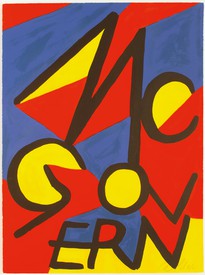
The Art History of Presidential Campaign Posters
Confronting the backdrop of the 2020 U.s. presidential election, historian Hal Wert takes the states through the creative and political evolution of American entrada posters, from their origin in 1844 to the present. In an interview with Quarterly editor Gillian Jakab, Wert highlights an array of landmark posters and the artists who made them.
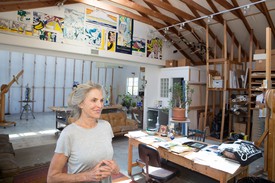
In Conversation
Dorothy Lichtenstein
Dorothy Lichtenstein sits down with Derek Blasberg to discuss the changes underway at the Lichtenstein Foundation, life in the 1960s, and what brought her to—and kept her in—the Hamptons.
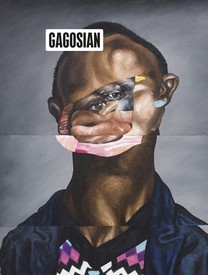
Now available
Gagosian Quarterly Fall 2019
The Fall 2019 upshot of Gagosian Quarterly is now available, featuring a detail from Sinking(2019) past Nathaniel Mary Quinn on its encompass.
Visions of the Self: Jenny Saville on Rembrandt
Jenny Saville reveals the process behind her new cocky-portrait, painted in response to Rembrandt's masterpiece Self-Portrait with Two Circles.
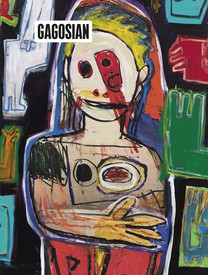
Gagosian Quarterly Wintertime 2018
The Wintertime 2018 issue ofGagosian Quarterly is now bachelor. Our comprehend this outcome comes fromHigh Times, a new body of work by Richard Prince.
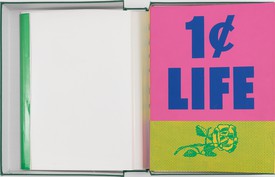
Book Corner
1-Cent Life
A 1964 publication by the Chinese-American creative person and poet Walasse Ting and Abstract Expressionist painter Sam Francis.

Desire
Diana Widmaier Picasso, curator of the exhibition Desire, reflects on the history of eroticism in art.
Greene Street Mural
Jack Cowart, Executive Director of the Roy Lichtenstein Foundation, and Rob McKeever, a sometime assistant to Lichtenstein, recall the making of the original Greene Street Mura 50.
Behind the Art
Time-lapse: Greene Street Mural
More than xxx years later on its creation, Gagosian presents a full-scale painted replica of the original Greene Street Mural by Roy Lichtenstein, based on documentation from the creative person's studio and produced by sign painters under the supervision of his quondam studio assistant.
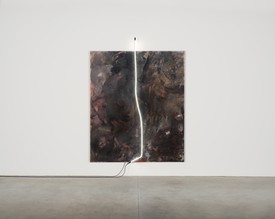
Mary Weatherford: The Flaying of Marsyas
Coinciding with the 59th Venice Biennale, an exhibition at the Museo di Palazzo Grimani in Venice presents new paintings by Mary Weatherford inspired by Titian'southward The Flaying of Marsyas (1570–76). Francine Prose traces the development of these works.
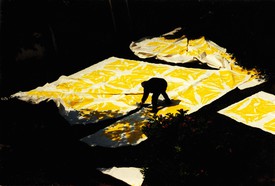
Simon Hantaï: Les blancs de la couleur, la couleur du blanc
Anne Baldassari reflects on the art historical influences and radical breaks reflected in the creative person'southward work with color.
johnswoperand1967.blogspot.com
Source: https://gagosian.com/quarterly/2019/04/18/roy-lichtenstein-19611965-essay/
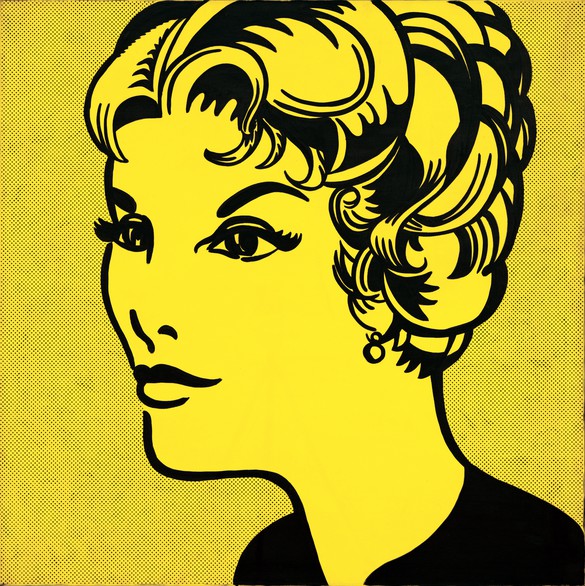
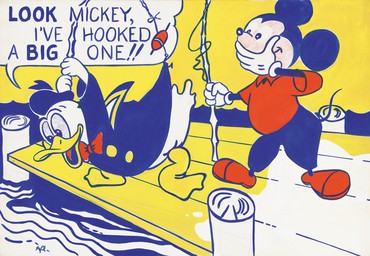
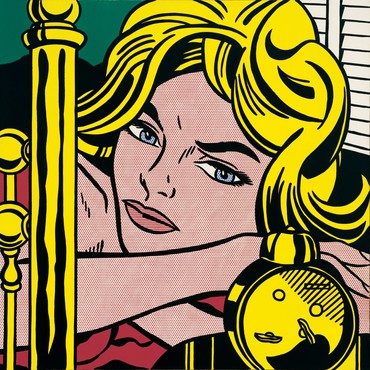
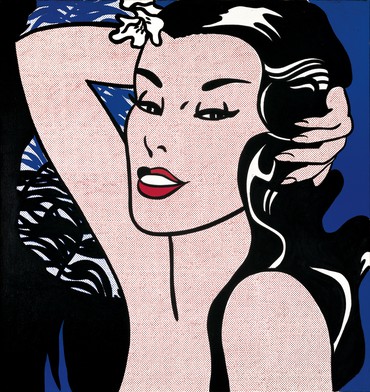
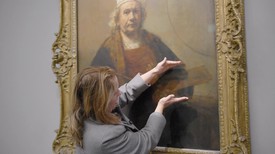
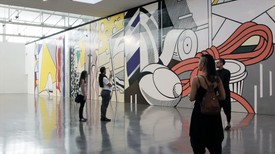

Postar um comentário for "Roy Lichtenstein 6 X 9 of Art 1962 the Ring Small"